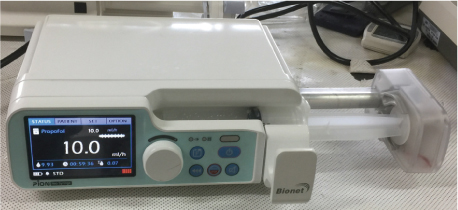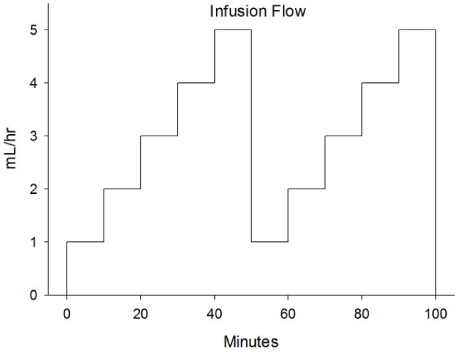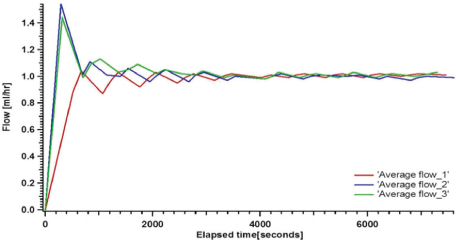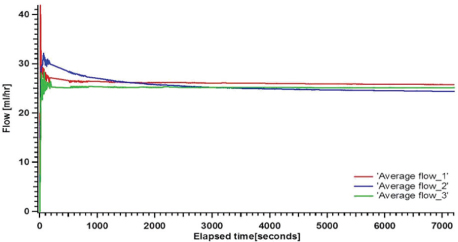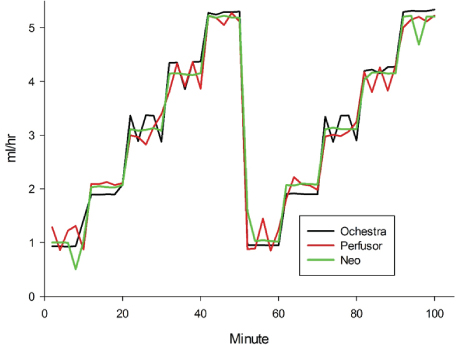J Dent Anesth Pain Med.
2016 Dec;16(4):303-307. 10.17245/jdapm.2016.16.4.303.
Efficacy evaluation of syringe pump developed for continuous drug infusion
- Affiliations
-
- 1Medical Device Development Center, Daegu-Gyeongbuk Medical Innovation Foundation, Daegu, Korea. soowon@dgmif.re.kr
- 2Department of Dental Anesthesiology, School of Dentistry, Seoul National University, Seoul, Korea.
- 3R&D Center, Bionet Co., Ltd, Seoul, Korea.
- KMID: 2366159
- DOI: http://doi.org/10.17245/jdapm.2016.16.4.303
Abstract
- BACKGROUND
In dental intravenous sedation, continuous intravenous infusion of a low-dose drug requires an infusion pump such as a syringe pump. To develop a new syringe pump for clinical use, the functions of the pump must meet certain international standards. Various safety and efficacy tests must be performed on the syringe pump, as stipulated by these standards, and an approval must be received from the approving agency based on such test results.
METHODS
The authors of the present study developed a novel syringe pump and performed efficacy evaluation by testing its infusion speed at 1 and 25 ml/h, and infusion performance testing at 2 and 24 h. Moreover, performance evaluation was conducted by comparing the novel pump to an existing pump with the infusion speed varied from 1 to 5 ml/h.
RESULTS
In the efficacy testing on the newly developed syringe pump, infusion with the infusion speed initially set to 1 ml/h resulted in infusion speeds of 1.00 and 0.99 ml/h in the 2- and 24-h assessment, respectively. Changing the infusion speed setting to 25 ml/h resulted in an infusion speed of 25.09 and 23.92 ml/h in the 2- and 24-h assessment, respectively. These results show no significant differences when compared with other commercially available pumps.
CONCLUSIONS
The efficacy testing of the newly developed syringe pump showed the accuracy to be within tolerance. Based on these findings, we believe that the newly developed syringe pump is suitable for clinical use.
Keyword
Figure
Reference
-
1. Jacobs B. Using an infusion pump safely. Nursing. 2006; 36:24.
Article2. Struys MM, De Smet T, Glen JI, Vereecke HE, Absalom AR, Schnider TW. The history of target-controlled infusion. Anesth Analg. 2016; 122:56–69.
Article3. Oei-Lim VL, White M, Kalkman CJ, Engbers FH, Makkes PC, Ooms WG. Pharmacokinetics of propofol during conscious sedation using target-controlled infusion in anxious patients undergoing dental treatment. Br J Anaesth. 1998; 80:324–331.
Article4. Seo KS, Lee K. Smart syringe pumps for drug infusion during dental intravenous sedation. J Dent Anesth Pain Med. 2016; 16:165–173.
Article5. International Electrotechnical Commission (IEC). Medical electrical equipment—part 2-24: Particular requirements for the safety of infusion pumps and controllers. 2012. IEC 60601-2-24.6. Lonnqvist PA, Lofqvist B. Design flaw can convert commercially available continuous syringe pumps to intermittent bolus injectors. Intensive Care Med. 1997; 23:998–1001.
Article7. Miller KE, Arnold R, Capan M, Campbell M, Zern SC, Dressler R, et al. Improving infusion pump safety through usability testing. J Nurs Care Qual. 2016; [Epub ahead of print].
Article8. Masuda A, Arai Y, Hirota K, Shibuya N, Ito Y. Misuse of infusion pump during propofol anaesthesia. Can J Anaesth. 1998; 45:187.
Article9. Jacobs B. Pump away high-risk infusion errors. Nurs Manage. 2005; 36:40–44.
Article10. Rooke GA, Bowdle TA. Syringe pumps for infusion of vasoactive drugs: Mechanical idiosyncrasies and recommended operating procedures. Anesth Analg. 1994; 78:150–156.11. Deckert D, Buerkle C, Neurauter A, Hamm P, Lindner KH, Wenzel V. The effects of multiple infusion line extensions on occlusion alarm function of an infusion pump. Anesth Analg. 2009; 108:518–520.
Article
- Full Text Links
- Actions
-
Cited
- CITED
-
- Close
- Share
- Similar articles
-
- Smart syringe pumps for drug infusion during dental intravenous sedation
- Comparison of Operator Workloads Associated with the Single-unit Anyfusion® Pump and the Changeover from a Syringe Pump to an Infusion Pump
- Accuracy assessment of a PION TCI pump based on international standards
- An Automatic System for the Delivery of Eye-Drops Using a Microinfusion Pump
- Accuracy and Continuity of Infusion Devices with Volumetric Analyzer

